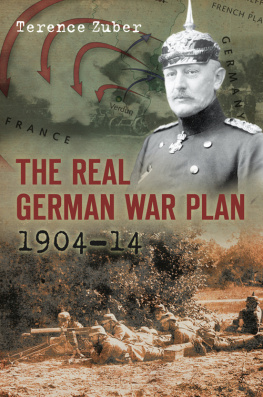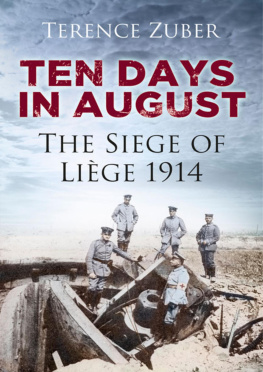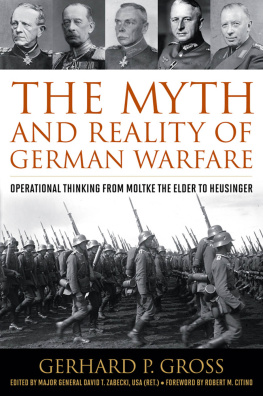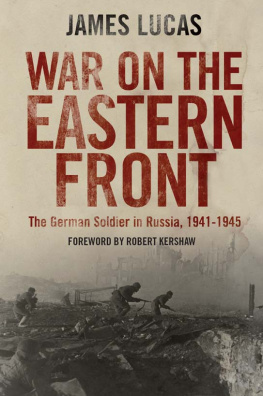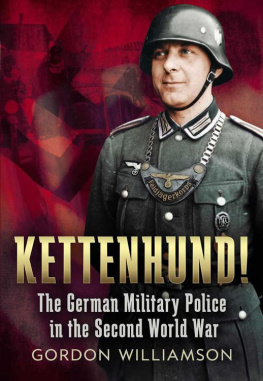
For LTC Eldon K. Schroeder
Commander 2nd Battalion 2nd Infantry
CONTENTS
I am deeply indebted to the History Department of the University of Wrzburg, and especially my Doktorvater, Professor Wolfgang Altgeld, and Professor Rainer Schmidt for their insistence on the central importance of primary sources in the study of history. I conducted research for this book at the Kriegsarchiv in Munich, the Militrarchiv in Freiburg, the Hauptsstaatsarchiv in Stuttgart and in Dresden and the Generallandesarchiv in Karlsruhe, of which I have nothing but the fondest memories.
Publishing with The History Press is a pleasure. I want in particular to thank my editors, Simon Hamlet and Abbie Wood. Heather Wetzel and Herr Klaus Schinagl prepared the maps. West Virginia Northern Community College has given me invaluable administrative support, and the Dean, Larry Tackett, has assisted with his computer expertise.
The Schlieffen Plan
From 1920 until 1999 very little was known concerning German war planning prior to the Great War. It was, however, common knowledge that in 1914 the Germans had been following the Schlieffen plan, which was presented in a Denkschrift (study) written by the German chief of the general staff, Count Alfred von Schlieffen, and dated December 1905. Beginning in 1920, semi-official histories, written by retired First World War German army officers such as Lieutenant-Colonel Wolfgang Foerster, General Hermann von Kuhl and General Wilhelm Groener, as well as the first volume of the official history of the war produced by the Reichsarchiv in 1925, first revealed the Schlieffen plan, not as the complete document but as a very general paraphrase. The intent of the Schlieffen plan was to annihilate the French army in one quick enormous battle (Vernichtungsschlacht). The concept was to deploy seven-eighths of the German army between Metz and Aachen, on the right wing of the German front, leaving one-eighth of the army to guard the left flank in Lorraine against a French attack. No forces would be sent to protect East Prussia against the Russians. The right wing would sweep through Belgium and northern France, if necessary swinging to the west of Paris, continually turning the French left flank, and eventually pushing the French army into Switzerland.
If the French attacked the German left, in Lorraine, they would be doing the Germans a favour, for the attack would accomplish nothing and the French forces in the north would be that much weaker. Groener et al. (the Schlieffen School) maintained that this Denkschrift represented the culmination of Schlieffens military thought and provided Germany with a nearly infallible war plan; all that Schlieffens successor, Helmuth von Moltke, needed to do was to execute the Schlieffen plan, and Germany would have been practically assured of victory in August 1914. They contended that Moltke did not understand the concept of the Schlieffen plan and modified it watered it down by strengthening the forces on the left wing at the expense of the main attack on the right. For this reason, the German army failed to destroy the French army in the initial campaign in the west in 1914.
The original war plans of both Schlieffen and Moltke were kept under tight control in the Reichsarchiv on the Brauhausberg in Potsdam and treated as secret documents, made available only to reliable officer-historians and then strictly on a need to know basis. The details of Schlieffens planning were never revealed. Moreover, nothing was known of the war planning from 1906 to 1914 of Schlieffens successor, the younger Moltke, aside from the fact that he had watered down the Schlieffen plan. The German army archive was then destroyed by British bombers on the night of 14 April 1945.
It seemed that only the original text of the famous Schlieffen plan Denkschrift had survived the bombing, because it had been transferred out of Potsdam. It had been seized by the American army and in the early 1950s was stored in the American National Archives, where Gerhard Ritter found it. He published the text in German in 1956 (in English in 1958). In preparing the plan for publication, Ritter learned from Foerster that the Denkschrift had actually been written in January and February 1906, after Schlieffen had retired (and no longer had any authority to write war plans), and backdated to make it appear that it was written while he was still chief of the general staff.
Ritter did not submit the Denkschrift to a thorough analysis, nor did he explain the many inconsistencies it contained. Instead, he concluded that the Denkschrift confirmed that the Schlieffen plan was the template for the German war plan in 1914. Ritter further deduced that the Germans had an aggressive war plan, which was the proximate cause of the Great War. Ritters opinions became common knowledge, so much so that the Schlieffen plan is a question in British A-level school-leaving examinations and the topic of commercially available term papers.
The Schlieffen Plans Ghost Divisions
During the tenure of both Schlieffen and Moltke, the German army conscripted only 55 per cent of each year group. Both Schlieffen and Moltke argued that this was insufficient and that Germany needed to implement genuine universal conscription. This was never accomplished in peacetime for two reasons: the expense of the High Seas Fleet and the fundamental opposition of the German Socialist Party (SPD) to the German army. The SPD was doctrinaire Marxist, opposed to militarism and convinced that the European proletariat would make war impossible by paralysing mobilisation with a general strike. The SPDs motto was not one man, not one penny for the army, and any attempt by the German government to increase the size of the army would bring on a domestic political crisis that was best avoided.
The Reichsarchiv history freely acknowledged that Schlieffen did not have enough divisions to execute the plan outlined in the Denkschrift: a number of the reserve corps which were employed [in the Schlieffen plan] as complete [two-division] corps, did not have the second division. The mobilization plan [also] did not provide for the immediate creation of the [eight] ersatz corps. The Reichsarchiv said that the need to raise these units was an integral part of the plan and Schlieffens legacy to Moltke. Most of these divisions were never established.
Inventing the Schlieffen Plan
Unknown to all but a few East German and Soviet archivists, several documents had survived the Potsdam bombing because they were in a nearby undamaged office building. They had been seized by the Red Army and returned to the East German military archive, but not made available to historians. With the fall of the Wall these documents came into the possession of the unified German military archives at Freiburg, and therefore were accessible for historical research. Foremost among these documents were two Reichsarchiv studies: Wilhelm Dieckmanns Der Schlieffenplan, a summary of Schlieffens planning until 1904, and Hellmuth Greiners analysis of the German west front intelligence estimate from 1885 to 1914.
I utilised these documents, along with several of Schlieffens war games in the Bavarian army archive in Munich, to produce a fundamental reappraisal of Schlieffens planning in The Schlieffen Plan Reconsidered in War in History, I pointed out that the Schlieffen plan was for a one-front war against France only, which was unlikely in 1906 and impossible in 1914. Even in this one-front war, the plan required twenty-four divisions that existed neither in 1906 nor in 1914. Schlieffens purpose was not to write a war plan using ghost divisions but as one more proposal to realise full conscription. He wanted to show that even a one-front war against France, and even with twenty-four non-existent ghost divisions, the German army was going to have its hands full.
Next page
